Medieval weapons in miniatures
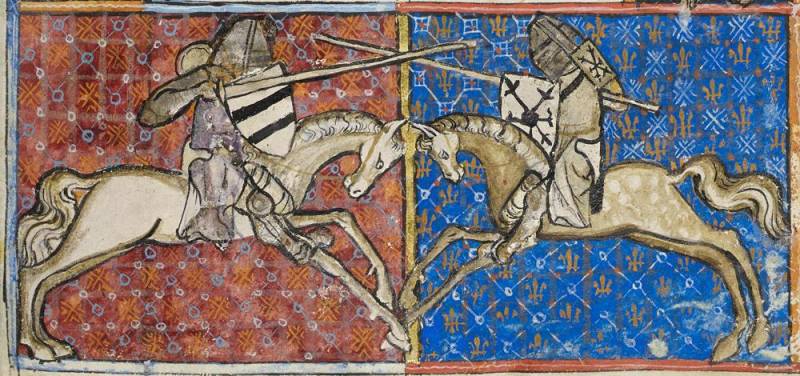
In the Middle Ages, it was the spear that was the main weapons equestrian jousting. Walter de Milimet: "On the nobility, wisdom and prudence of kings", 1326-1327. Christ Church, London
shields and armor, bows and arrows, and maces, and spears;
I will burn them for seven years. And they will not carry firewood from the field,
nor cut down from the forests, but only weapons will be burned;
And they will plunder their robbers…”
Ezekiel 39:9, 10
History Middle Ages. Today we have ... a completely “passing” article, containing absolutely nothing new, except for beautiful miniatures from medieval manuscripts.
Let me remind you that there are a lot of them, so many that it is impossible to say, for example, only 86 copies were made according to Jean Fraussard's Chronicle alone. He himself had already died, and copies continued to be rewritten and decorated with miniatures, so they are all different, although the texts are almost the same. And they are located in a variety of places, ranging from the British Library to the Pierpont Morgan Museum and Library. And each has its own set of illustrations, and each is informative in its own way.
And today we will briefly go over the entire history of knightly weapons, and “pictures” from manuscripts will be used as illustrations, with the exact design of the captions. This is in case any of the readers of VO is inspired by this topic and decides to test their creative powers in writing historical articles with miniatures from manuscripts as decoration. What the hell is not joking, suddenly someone in this topic will try himself. So, let's begin…
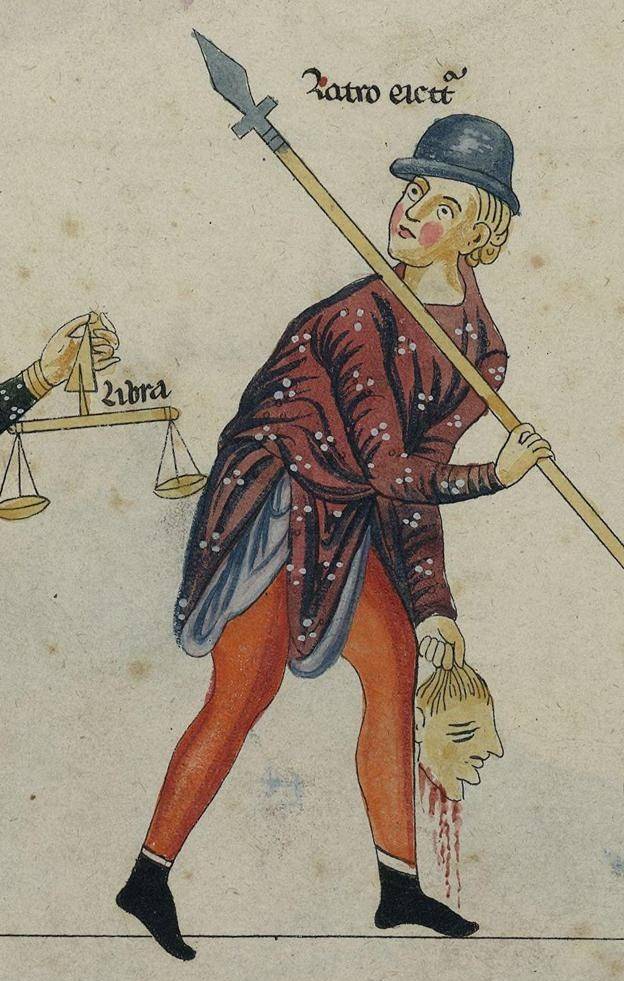
"Winged Spear". Fragment of a miniature from the manuscript of Gerrada of Landsberg "The Garden of Delights", 1195 Alsatian library Credit Mutuel, Strasbourg, France
First of all, we note that on the miniatures of 476-1450. most often depicted such weapons as a spear. Which, of course, tells us that it has been the most common type of weapon since ancient times.
As you know, the oldest spearheads were found in East Africa long before the Middle Ages. They are about 280 thousand years old, that is, they are 80 thousand years older than the earliest remains of people of the modern species Homo sapiens, and 200 thousand years older than other samples of similar artifacts that were still considered the oldest!
Spears in antiquity were used everywhere, and the soldiers of the European "barbarian kingdoms" also got from the dead ancient Rome. Moreover, they were mainly with tips of two types: without a crossbar on the sleeve and with a crossbar in the form of two rather long protrusions - the so-called "winged spear". The crossbar did not allow the tip to enter far into the body of the enemy, but it increased the cost of the tip, since at that time there was a shortage of metal in Europe. That is why on the hunting spears of the X-XV centuries. instead of a metal crossbar, a wooden stick on a strap was used. She got up across the movement of the shaft and created an emphasis on it!
Both horsemen and foot soldiers used such spears, only the horsemen's spears at that time were almost always longer than the spears of the infantry. Then, at the beginning of the XNUMXth century, a round metal plate was added to the horseman's spear on the pole, which in England was called the "wamplet", and in France the rondel. At the beginning of the XNUMXth century, one can already detect the difference between spears for war and for knightly tournaments.
Miniatures from this period show us that the difference was that the spearheads, as before, were either flat or needle-shaped. But those that were used in tournaments became blunt. Moreover, tournament spears were often drilled inside so that they would break even with a not very strong blow, and thereby save the lives of the participants in the competition.
Combat spears had the same shape, but with a sharp tip. It is interesting that if suddenly the knights were ordered to dismount and go into battle, like infantrymen, they had to chop off shafts that were too long to make it more convenient to fight with spears in hand-to-hand combat. Spear shafts at that time were usually made of ash.
So it’s by no means a sword, as many people think, but it was the spear that was the most massive weapon of the Middle Ages, both proud knights and commoner infantry. Their consumption was also large. So, only one knight Ulrich von Liechtenstein broke 307 spears in just one "tournament season"! That is, their "production" was truly massive!
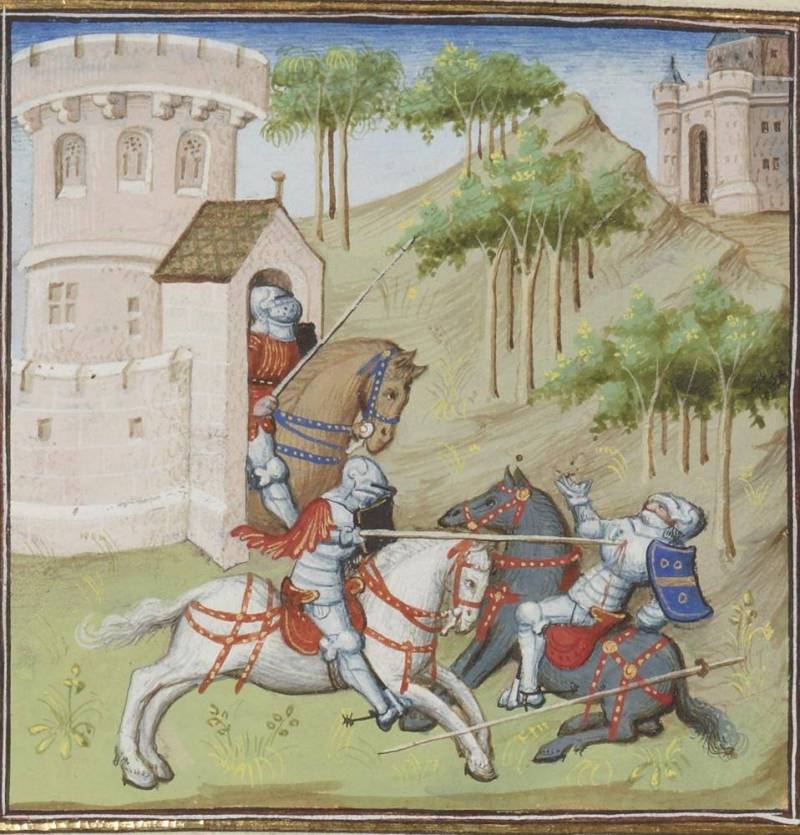
Knightly duel on spears. The spear on the ground already has a wampite. Giron le Courtois, 1420 National Library of France, Paris
The sword is the second most important weapon of the Middle Ages, and to a greater extent the weapon of the knights, and not the foot soldiers, since good swords, like armor, have always been piece work.
Medieval swords had as their ancestor a Roman sword called a spata and suitable for both cavalry and infantry. However, they stretched out in length, and over time received a handle of a different shape. For some reason, some of us believe that medieval swords were excessively heavy. I have heard that they weighed 5, and 15, and even ... 50 kg!
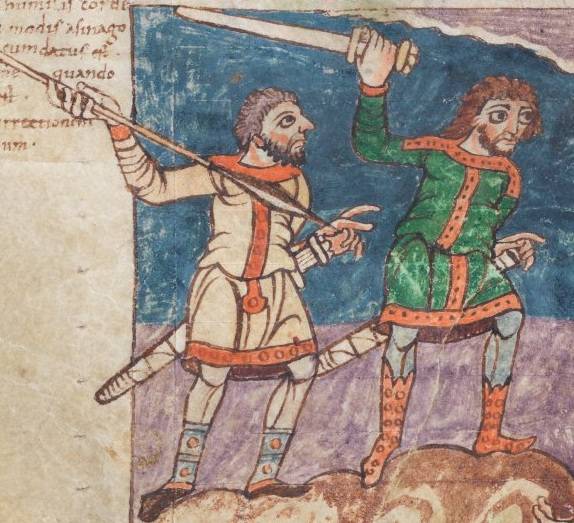
"Carolingian" sword in the "Stuttgart Psalter", ca. 830 Württemberg State Library, Stuttgart
But this is all fiction! In fact, the weight of a medieval sword, ranging from the "Carolingians" of the era of Charlemagne and his heirs, Viking swords and "Crusader swords", averaged only one kilogram - some weighed a little more, some less.
Two-handed swords, with which novelists and filmmakers love to equip their heroes, were not at all the weapons of knights, and they began to spread en masse only ... in the 1240th century! But “swords in one and a half hands” or “bastard swords” (that is, with an elongated handle, so that they could be held with two hands), which appeared around 94, did exist. The largest swords of this type were distinguished by blades from 102 to 23 cm and handles of XNUMX cm.
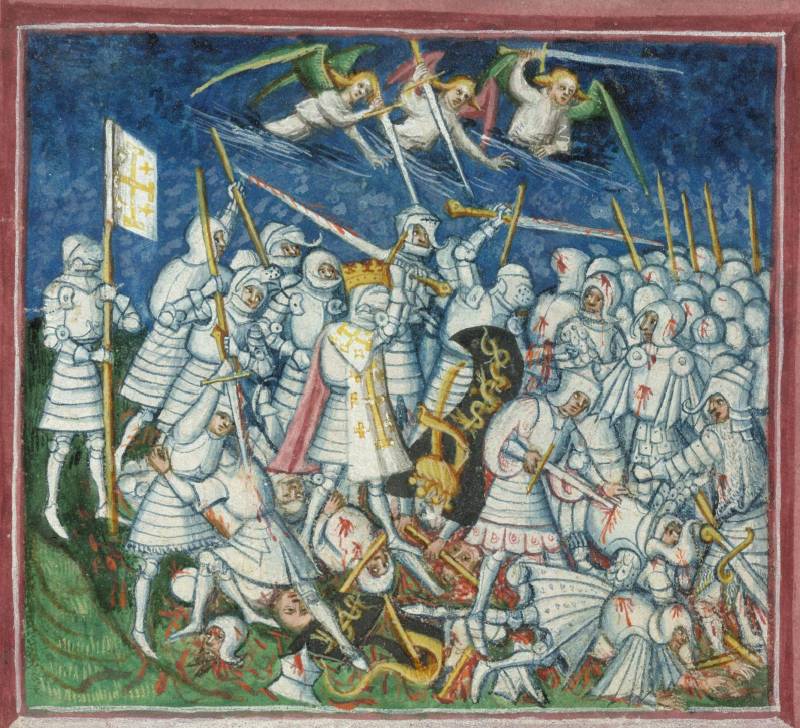
Knights with swords in "one and a half hands". On the left in the hands of a warrior is the banner of the Kingdom of Jerusalem. "Lives of Saints Edmund and Fremund" 1433-1434 Bury St Edmunds, British Library, London
Historians have long noticed that earlier swords differ from later ones. The former have a wide, straight, slightly pointed blade with one fuller on each side (the fuller is a groove in the center of the blade to lighten the weight). The second ones look like an elongated triangle, usually with a rhombic or hexagonal section. Their weight is about the same, but the first is more convenient to chop, but the second - to prick!
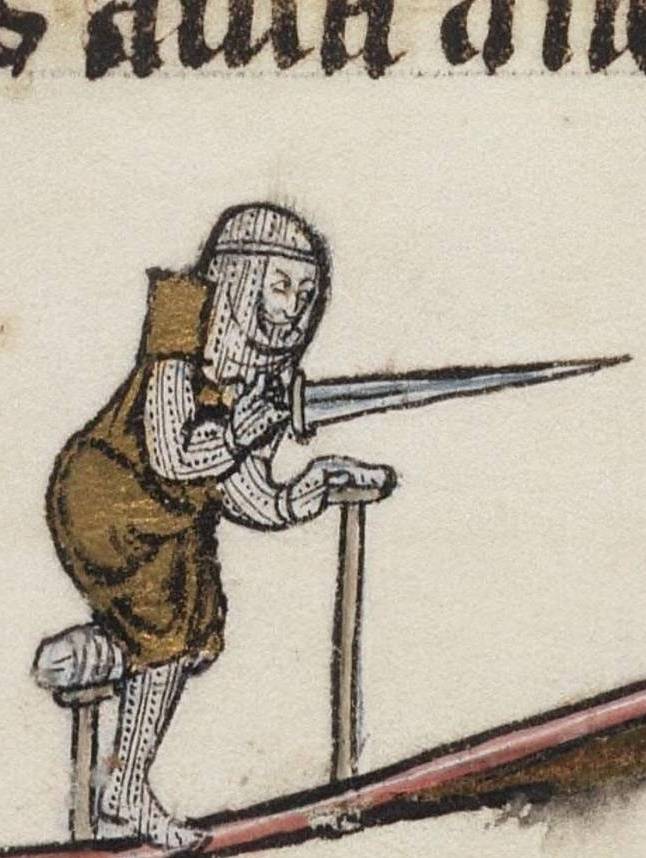
Miniature from "Romances about Arthur". It depicts a one-legged knight with a stick and a sword of a purely piercing type. Manuscript 1275–1300 France. Yale University Library, New Haven
To distinguish them all, the English historian Ewart Oakeshott came up with a typology accepted today by most historians. It has 10 types of cutting swords and 12 types of stabbing. The easiest way, however, is to distinguish them by time: until 1280, swords were mainly chopping, but then they were piercing, since plate armor appeared on the warriors.
Again, judging by the illustrations from manuscript I.33, known as "Fechtbuch of the Tower", written around 1300, or between 1270 and 1340, fencing already existed then, and it was taught like any other skill. And if “in the times of the Vikings” the blows were rare, but strong, and reflected them with a large round shield with a umbon, then on the miniatures from this manuscript all the main blows are shown as stabbing, but the shield is a small round buckler. That is, they were fencing with swords already at the end of the XNUMXth century, and with the advent of armor, it became absolutely necessary to inflict an injection in places covered not with plates, but only with chain mail, or with a point between them.
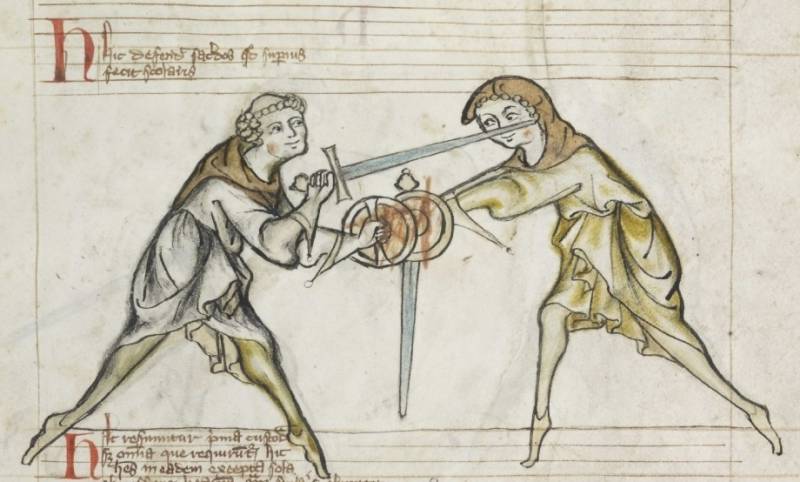
Sword duel. Miniature from the "Fechtbuch of the Tower" - the earliest known fencing textbook. Tower of London Manuscript I.33. Royal Armory
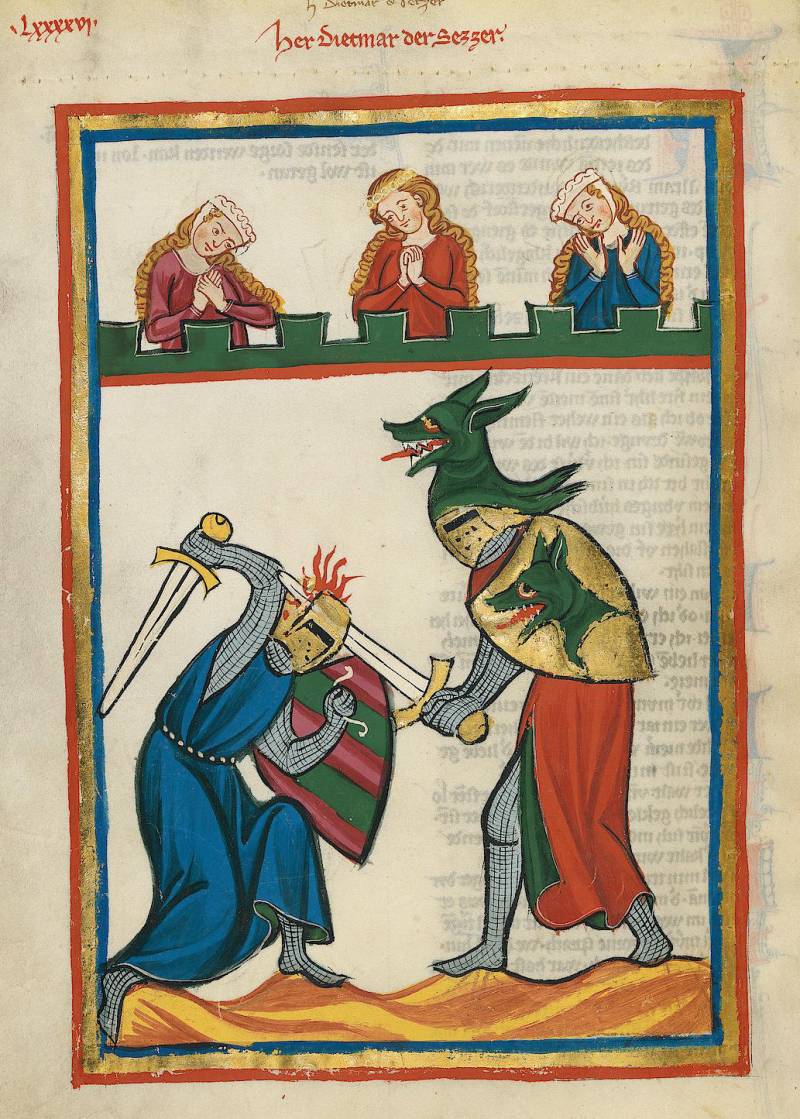
Exactly the same duel from the Manes Code. Knight Ditmar fights with swords with his opponent and… cuts his helmet with one blow! Codex Manes, ca. 1305–1315 Heidelberg University Library, Baden-Württemberg
European medieval swords were by no means always straight. Quite popular were ... "crooked swords." Somewhere around the middle of the XNUMXth century, the so-called felchens or falchions appeared, which had a point expanding towards the point, and at the same time often a curved blade. Due to this, having a center of gravity shifted forward, they had a very powerful cutting or chopping effect. Judging by the miniatures, they were used quite widely, but for some reason very few of them have survived to this day.
Another type of European "crooked sword" was Messers - blades that are the same across the entire width and with one-sided sharpening. For falchions and messers, the Elmslie typology has been developed - an analogue of the Oakeshott typology for swords with straight blades. The weight of the falchions, despite the part of the blade expanding like a machete, was about the same as that of the swords. For example, the famous "Falchion from Conyers" with a total length of 89 centimeters weighs only 1,3 kg. Moreover, they were used by both the simplest warriors and noble persons!
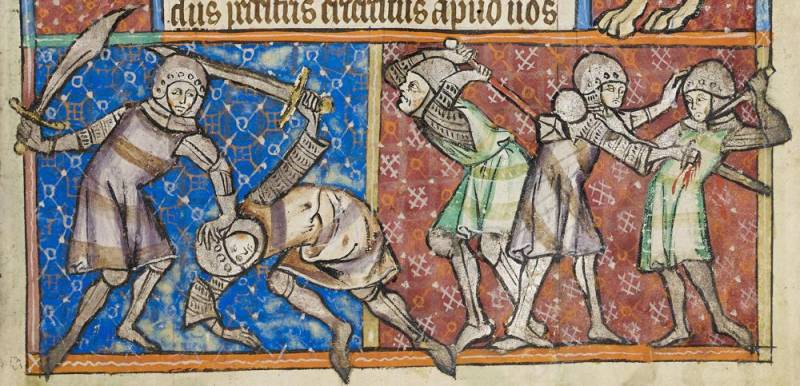
The warrior on the left is holding a falchion with a curved blade. Walter de Millimete. "On the nobility, wisdom and prudence of kings", 1326-1327. Christ Church, London
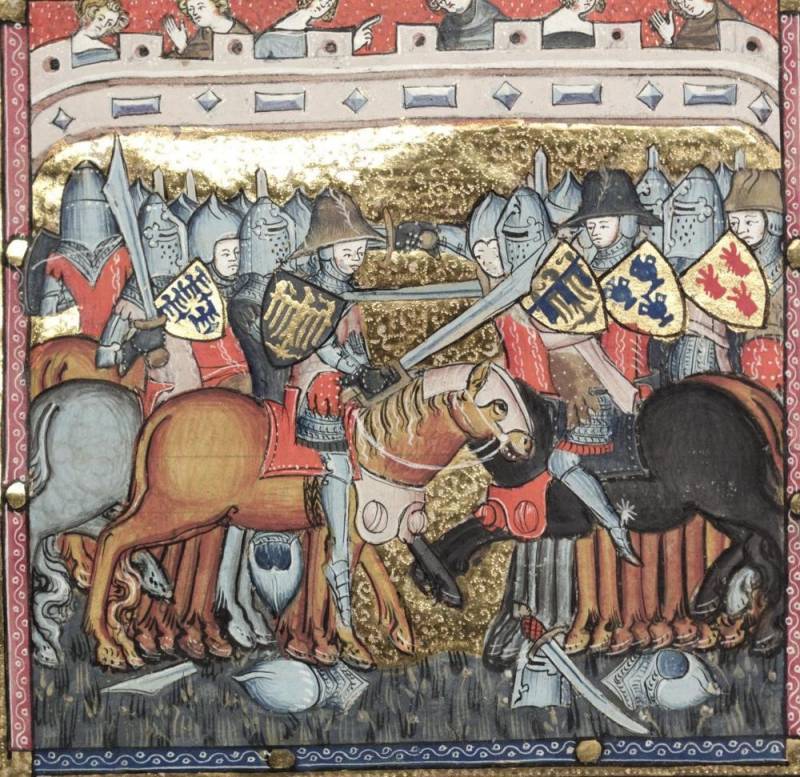
I did not disdain to fight them even to know. And for some reason, the knight in the hat has a saber guard! And on the ground lies another falchion and someone's messer, and the helmets from the heads of the combatants are falling! Walter de Millimete. "On the nobility, wisdom and prudence of kings", 1326-1327. Christ Church, London
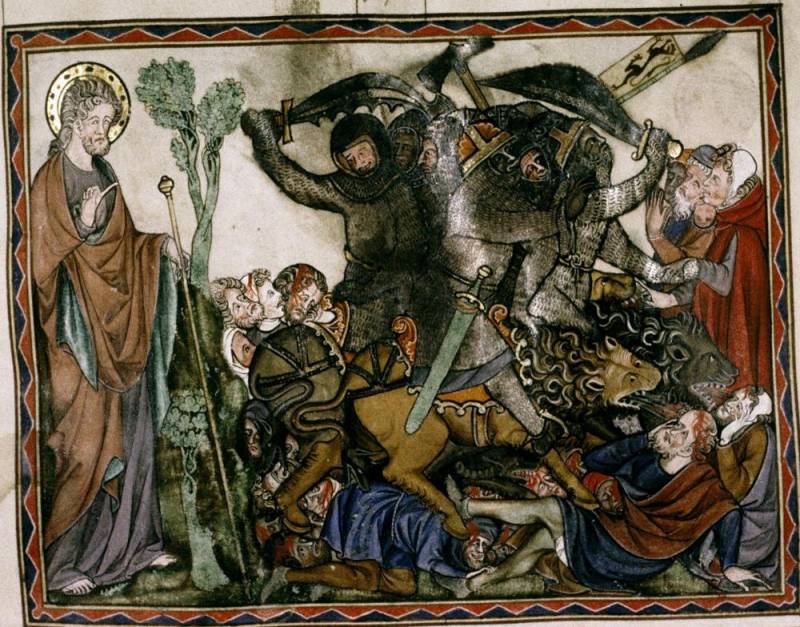
Surprisingly, it was falchions that miniaturists more often than other swords put into the hands of various demonic characters, and also subjected to obvious artistic exaggerations! "Soul Apocalypse", before 1275 or after 1250. Bodleian Library, Oxford University
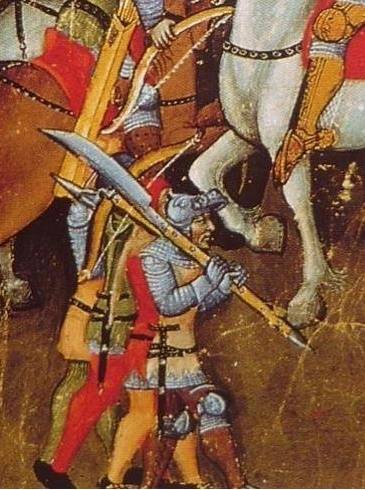
Fragment of a miniature from the manuscript "Good Civilians", Italy, 1373. Trivulziliana Library, Milan. There is a crossbow, and a bow, and a combat scythe, and even two basilard daggers ...
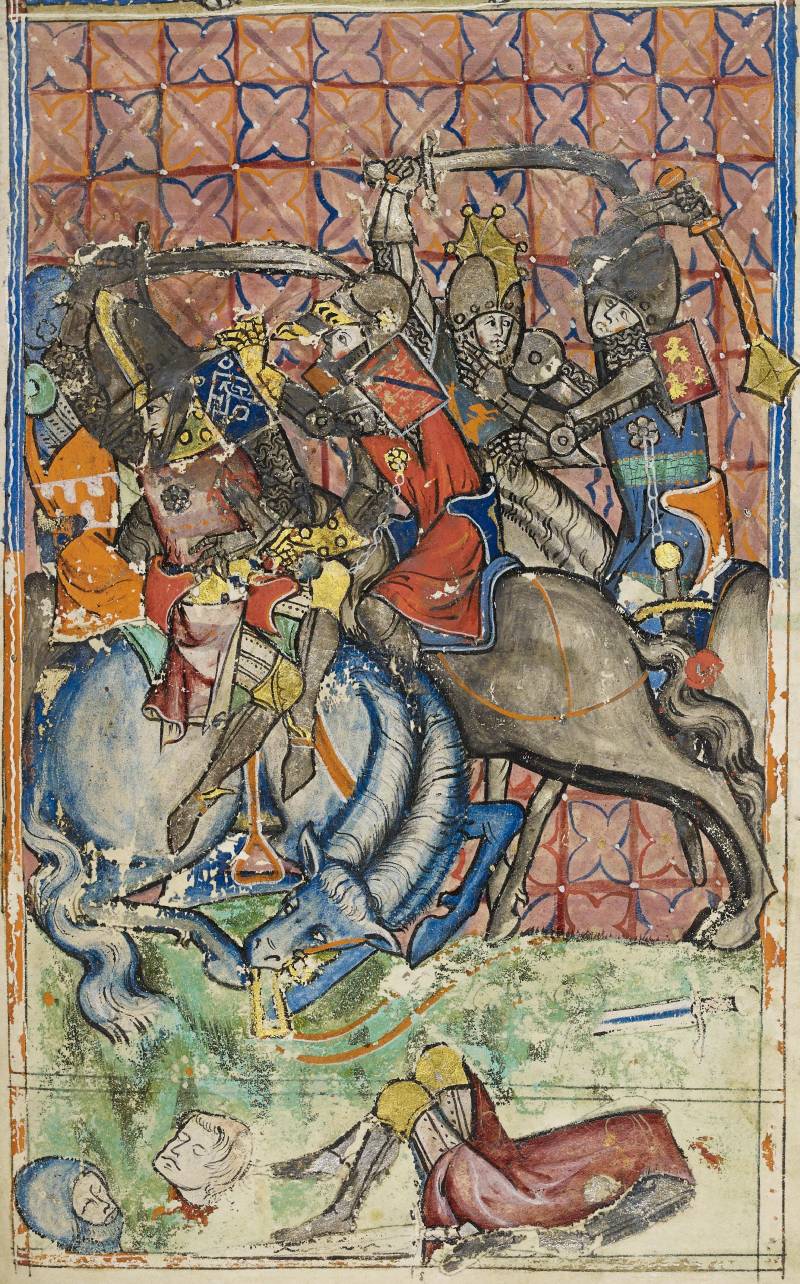
And here at once both Felchen, and Messer and ... shestoper - a mace with a warhead of six flat plates. By the way, here you can even see the chain, if you look closely, going to the hilt of the knight's sword in a red surcoat, depicted in the very center! Walter de Milemete: "On the Nobility, Wisdom and Prudence of Kings", 1326-1327 Christ Church, London
And, of course, both knights and foot soldiers used axes (with a moon-shaped blade and the letter “G” placed on the left side), as well as spiked clubs, called morgenstern. Very rare types of chopping weapons were also used, such as, for example, fauxhard (faux from the French “braid”). Indeed, the foshard most of all resembles a huge two-handed knife, although it was most likely not so easy to use it.
Images of such clubs in miniatures are rare. Axes more often, but also not always and not of all types. Therefore, it makes sense to show how it looked in the hands of a person, using for this a frame from the movie "Secrets of the Burgundy Court". There, both a mace with a cylindrical studded pommel and a battle ax with a T-shaped ax handle are very well shown.
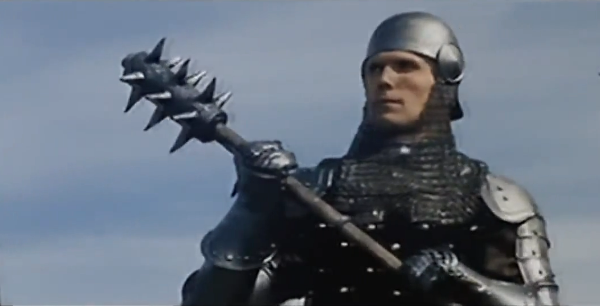
Mace. The choice of the Comte de Senac, a "bad man" played by the exceptionally charismatic Guy Delorme. Frame from the film "Secrets of the Burgundy Court"
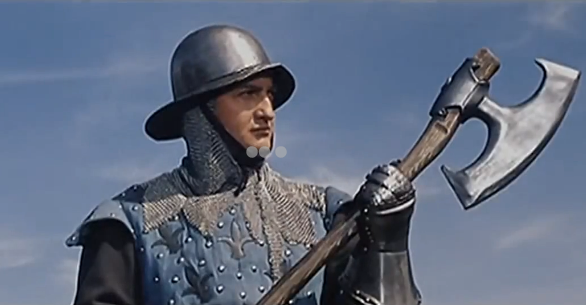
The ax was chosen by both main characters: both the positive Chevalier de Neuville (Jean Mare), and the same treacherous Comte de Senac. Frame from the film "Secrets of the Burgundy Court"
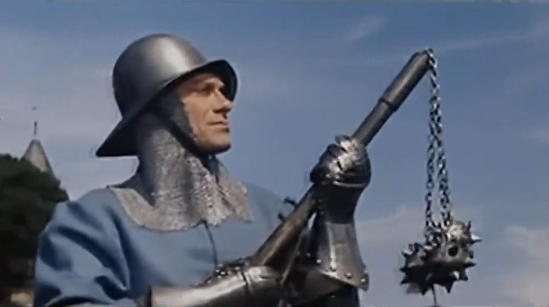
"Triple flail" - the choice of the Chevalier de Neuville. So in the movie this weapon is called and, it should be noted, in order to own it, a skill was required, and in this way it was possible to get hurt yourself. But with his help, the enemy could be quite easily disarmed, which Neuville did during the duel of God's judgment ...
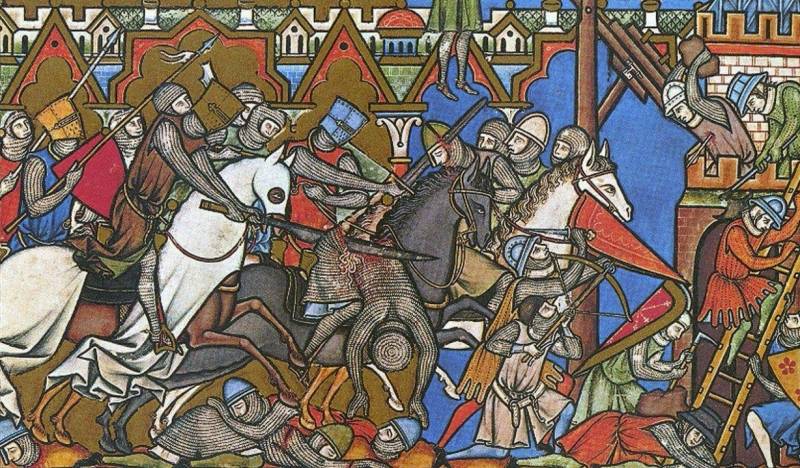
And here is complete naturalism, evidence that the illustrator of this manuscript was no stranger to military affairs: a knight with a two-handed foshard cuts the enemy into pieces, despite the chain mail, so much so that his intestines crawled out! Miniature from the Maciejowski Bible, 1240–1250. Pierpont Morgan Library and Museum, New York
Interestingly, the bow, for all its popularity and lethality, was not considered a knight's weapon. He was willingly used for hunting, even by women, but in battle it was simply indecent to shoot a fellow knight from a horse. Defeat him, knock him off his horse, take him prisoner, and then get a ransom from him - that was a worthy deed! And only commoners could shoot at enemies with a bow, and even more so with a crossbow, which was forbidden more than once by the popes of Rome.
Interestingly, the oldest bow was discovered in Spain on the shores of Lake Banyolas, in the vicinity of Barcelona. The age of the find, according to scientists, is 7,5 thousand years and is currently the oldest bow found. Moreover, it is quite well preserved, and it is clear that its inner side is flat, and the outer one is convex, and the length is 108 centimeters. It is made of very poisonous, but at the same time very useful for people, yew berry, which served as the material for most of the bows of Europe in the Neolithic and ... Middle Ages! Interestingly, a similar bow was also found next to the mummy of the ancient man Ötzi in the Alps.
In order to shoot accurately from a bow, it was necessary to constantly train, and in order not to lose the shape of the arrow, in the same England, the feudal lords from time to time arranged competitions for shooters from free peasants and celebrated the most accurate. This allowed the British to always have detachments of skilled shooters on hand, but the French had to hire detachments of Genoese crossbowmen for money.
By the way, the bows of the English archers themselves were very large, sometimes in human height and more. Arrows were fired at the advancing French cavalry on command, in volleys, at a certain angle and fell on the riders from above, hitting primarily their horses. Wounded horses fell, crushing riders, or lay down, unable to run further. Well, the archers themselves, taking advantage of the confusion, ran out from under the protection of stakes hammered into the ground (and they fought that way!) And ... with hammers with lead knobs they broke the heads of the knights!
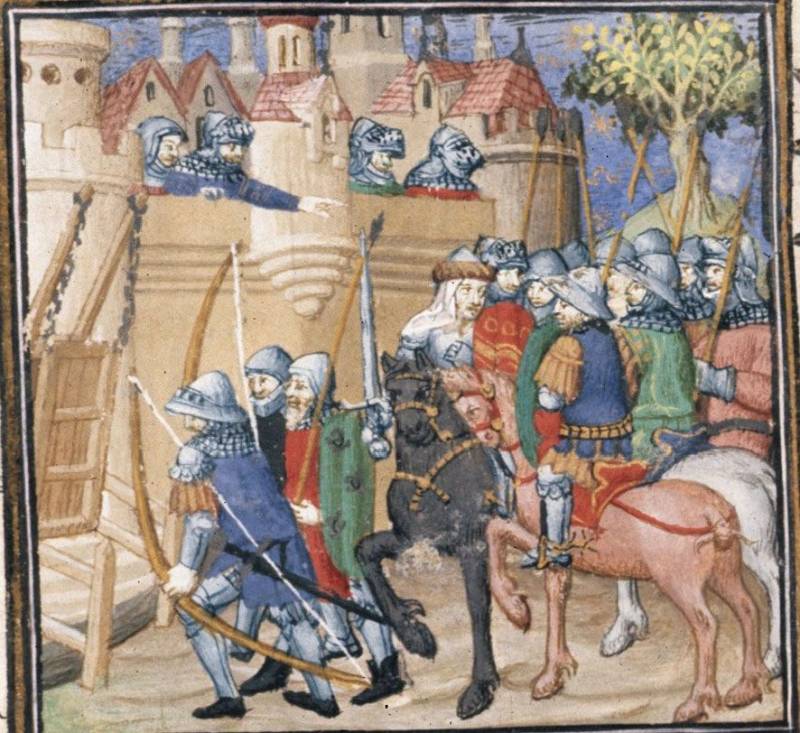
"History of Battles" or "The Book and True History of the Good King Alexander" (meaning, of course, Alexander the Great), 1400-1425. Paris. British Library, London
As for the crossbow, that is, a bow fixed on a stock with a trigger mechanism, it has also been known in Europe since Roman times, and began to spread from the XNUMXth century. This weapon was originally suitable only for hunting, since it was weaker than a bow. And it was weaker because the bow itself was short for convenience, and its bowstring was pulled by hand.
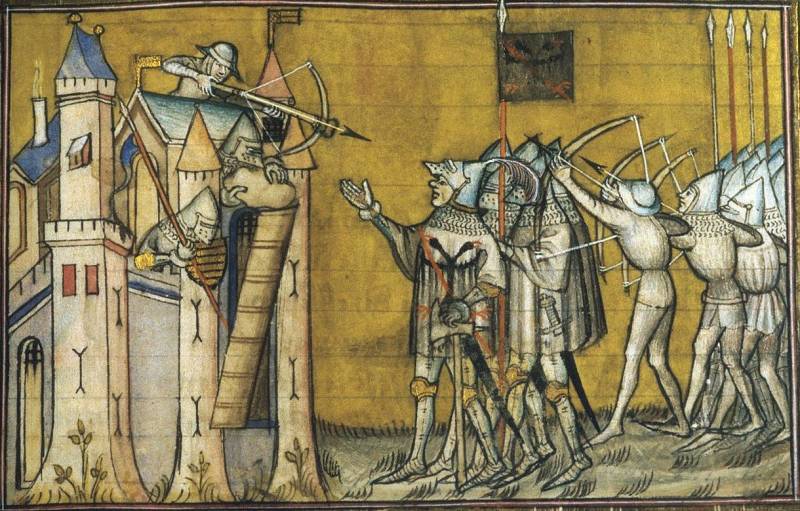
The illustrious knight of France, Bertrand du Guesclin (this is evidenced by his coat of arms on the jupon), offers the enemy fortress to surrender. Behind him are archers, ready to shoot, and crossbowmen defend the city. "The Song of Bertrand du Guesclin", 1380-1392 Paris. British Library, London
The popularity was facilitated by the fact that learning to shoot a crossbow was much easier and required less time compared to mastering the art of archery. In order to ease the tension, and at the same time make the crossbow lek stronger, they came up with the idea of stretching its bowstring with the help of belt hooks, first one, and then two.
The crossbowman inserted his foot into the stirrup at the end of the crossbow chute, leaned over, hooked the bowstring with a hook (or hooks), after which he unbent, and the bowstring was pulled with these hooks. Such a system has spread in Europe since the XIII century, and it was a serious step forward.
Crossbows became even more powerful during the years of the Hundred Years War, when a device called the "English gate" appeared. He had a chain hoist system, two handles and was worn on the butt. And in Germany, from the end of the XNUMXth century, they began to supply the crossbow with a rack and pinion mechanism called the kranekin. This type of tensioner was more convenient and stronger than the block one, and it made it possible to draw the bows of even the most powerful crossbows.
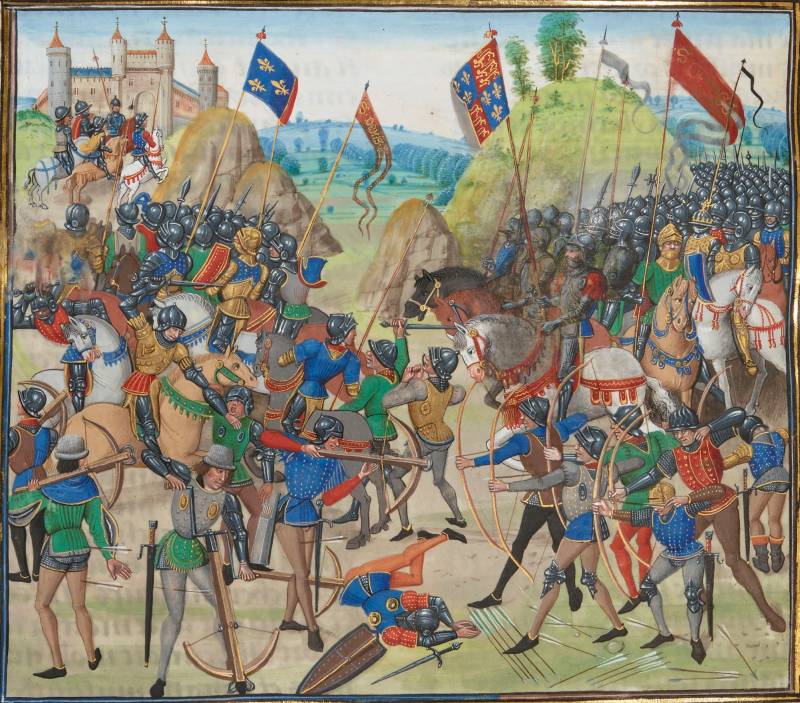
Genoese crossbowmen against English archers. The Battle of Crécy, 1346. Miniature from the Chronicles of Jean Froissart (1337–1410), illustrated copies commissioned by the Flemish nobleman Louis de Gruutuse in the 1470s. National Library of France, Paris
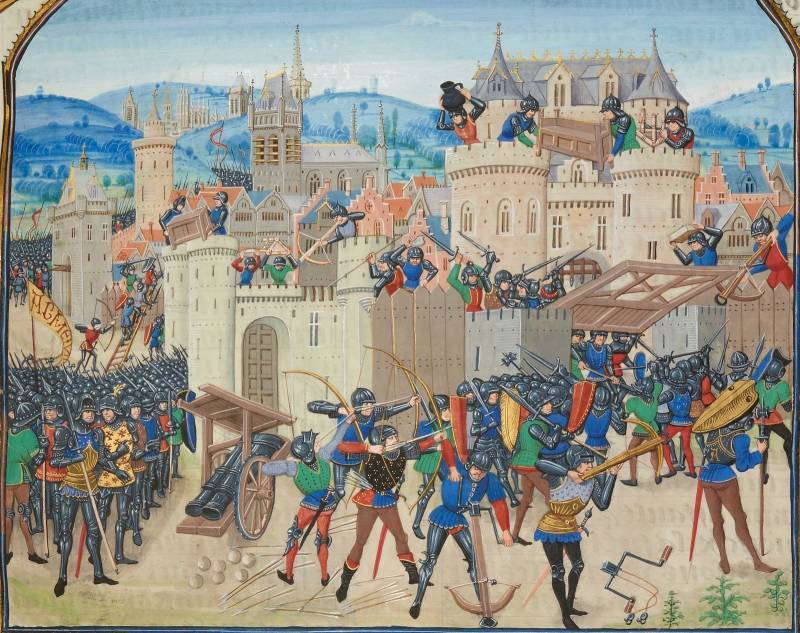
Archers and crossbowmen, using crossbows with an "English gate" (one such gate is on the ground), are shelling the city, supporting their comrades going on the assault. The defenders of the city throw furniture, stones and even pottery on the heads of the latter. The Siege of Aubenton, 1340 Miniature of Jean Froissart's (1337–1410) Chronicles, illustrated copies commissioned by the Flemish nobleman Louis de Gruutuse in the 1470s. National Library of France, Paris
On the basis of a miniature from the manuscript of Walter de Milimet "On the Nobility, Wisdom and Prudence of Kings", presented to the King of England Edward III upon his accession to the English throne, it can be concluded that gunpowder guns were already used in England in 1327, although they were very primitive. But they were improved and in the XNUMXth century they were already exploited very widely ...
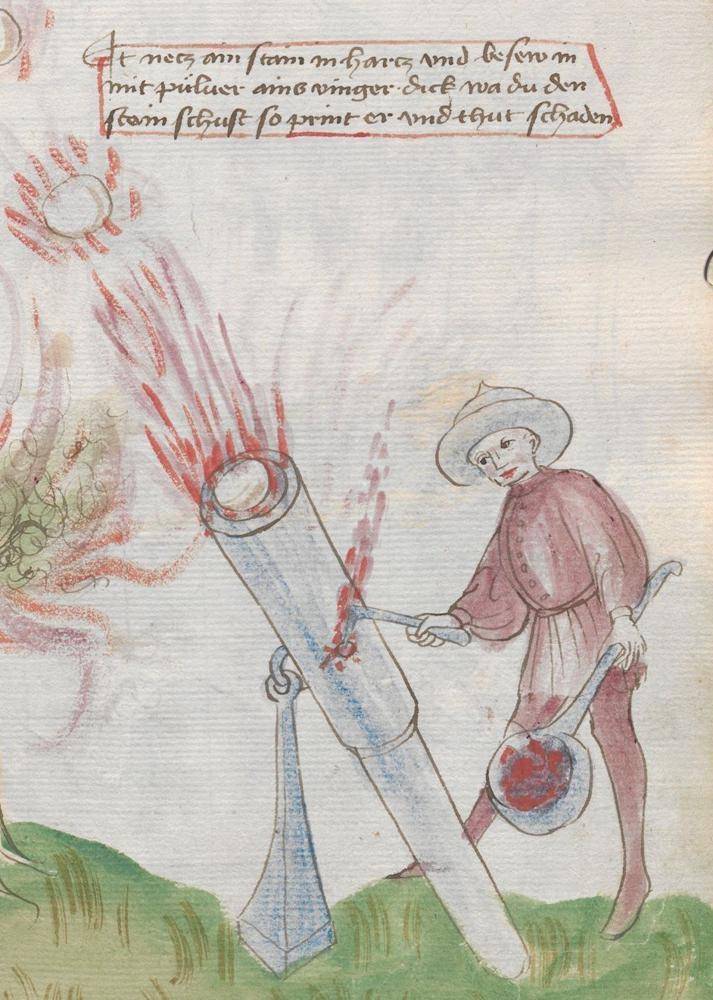
In this illustration, the shooter is holding a red-hot rod in one hand and a brazier with coals in the other. Why is a non-burning wick used? War Book, 1437 National Library of Austria, Vienna
And the thing is that the gunpowder of the XV century was a very fine powder, sticking together into clods. There was no air for combustion in it, so it was not possible to set fire to it in the barrels of guns, where it merged into one dense mass. I had to use a hot rod. From him, the saltpeter, which was part of the gunpowder, began to melt, released oxygen and the gunpowder flared up! Therefore, it was impossible to do without a brazier for a long time!
Surprisingly, the invention of gunpowder artillery did not immediately abolish the use of trebuchet-type throwing machines, which were used until the end of the XNUMXth century!
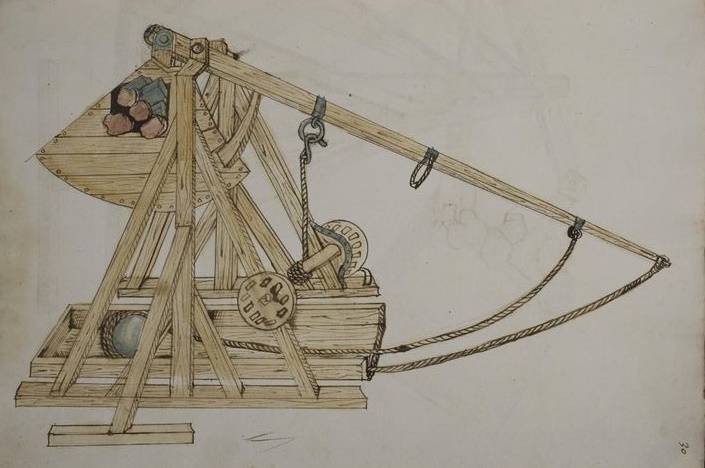
Trebuchet. Miniature of the manuscript "Book of War" 1496 Heidelberg University Library
Information